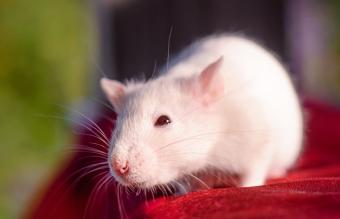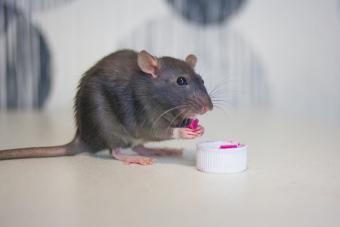
Pet rats come in a wide variety of colors, patterns, and coat types. While pet rats do not come in breeds the way cats and dogs do, the availability of colors, patterns, and body types are extensive. Consider the options available, determine the names you prefer, and choose a rat that is best for you and your family.
What Is a Fancy Rat?

A "Fancy" rat is a term for a rat that was bred to be a pet, as opposed to rats found in the wild. The standards for captive-bred rats are set by the American Fancy Rat & Mouse Association (AFRMA). The AFRMA categorizes rats by varieties and sections rather than by breed. This means that in terms of personality and other characteristics, there's little difference between the varieties and sections. Once you've settled on a rat as a pet, this means you can focus on the look you enjoy when choosing a new rodent buddy.
Varieties of Rats
There are seven varieties of rats recognized by AFRMA. Varieties refer to either the type of coat the rat has, ear shape, or other features. It's possible for a rat to be a member of multiple varieties. For example, you can have a rat that's a dumbo and a rex.
Bristle Coat
This rat variety has a coat that's coarse and wiry to the touch, hence their name. Their fur is also short.
Dumbo

This rat variety gets their name from the Disney cartoon elephant Dumbo. They have large, round ears that are set lower on the head than standard, "top" ears.
Hairless

Hairless rats are also called Sphynx rats, like the cat breed. These rats are either entirely hairless or have some small patches of fur on their faces. Hairless rats are often smaller than other varieties.
Rex

The rex rat has curly fur, somewhat like a Cornish Rex cat. They also have whiskers that look crumpled and wrinkled. A "double rex" rat has even curlier fur in smaller quantities, giving these rats a hairless appearance if viewed from far away.
Satin
Satin rats get their name from their soft, satiny fur. Their fur is also longer than that of a rex or standard rat.
Standard
A standard rat has a short coat with a smooth appearance and ears that sit on top of their head. Male standard rats have longer hair than females that may feel rougher to the touch and can be greasy.
Tailless
These rats lack a tail and their body shape is stockier and smaller compared to other varieties. Their back end may also appear rounder than other varieties due to the absence of a tail. These rats are sometimes referred to as Manx rats, like the tailless cat breed.
Dwarf
Dwarf rats are not recognized as a separate variety by AFRMA. These rats can be any of the varieties above, but they are about 30 percent of the size of the regular varieties.
Rat Sections
Rat sections refer to the rat's coloring and patterns. The AFRMA currently recognizes 40 different coat colors and patterns.
Self Coloring

A self coloring refers to a rat with a single solid color all over. Self colors include:
- Beige
- Black
- Blue
- Blue-beige
- Champagne
- Chocolate
- Cocoa
- Lilac
- Mink
- Platinum
- Powder blue
- Russian blue
- Russian dove
- Sky blue
- White
Silvered
A rat that is silvered has white hairs mixed in with another color, giving the second color a silvery sheen. Silvered rats come in:
- Amber
- Black
- Blue
- Chocolate
- Fawn
- Lilac
- Mink
Marked

Marked rats have distinctive color patterns on their bodies. The most commonly found marked rats are:
- Bareback - A white body with the head, neck, and shoulders another solid color
- Berkshire - A solid color on the "top" of the rat with a white belly, feet, tail, and some white on the head by the ears
- Blaze - A white "blaze" on the rat's muzzle, like the blaze on a horse, coupled with any other solid color or markings
- Capped - A white body with a head of another solid color
- Dalmatian - A white body with spots of another color all over the body
- Down Under - A solid color with a stripe or spots of another color on the belly
- English Irish - A solid color with a white triangle marking on their chest and white on their feet
- Essex - A white belly with a solid color on top that gradually fades into the white
- Hooded - A white body with a "hood" of another color covering their head, shoulders, and down the spine
- Irish - A solid color with a white marking on their belly, white feet, and white on the tip of the rat's tail
- Masked - A white body with another solid color on the rat's face area between the eyes and the top of the muzzle, forming a "mask"
- Variegated - A solid color on the rat's head and shoulders with spots and patches along the back over white; the belly, chest, and throat are also white
Any Other Color

These are rats that do not have any white on them and have multiple other colors. Colors in this section include:
- Agouti - A medium brown color ticked with black
- Blue agouti - A grey color ticked with blue
- Chinchilla - A pale grey color ticked with black
- Cinnamon - A light brown color ticked with a darker brown
- Cinnamon pearl - The rat's hair has multiple colors that lead to a golden color overall.
- Fawn - A fawn-colored hair color
- Lynx - A pale gray ticked with a darker brown and belly is pale gray
- Pearl - A very pale gray that appears like silver overall
- Russian blue agouti - A dark grey color ticked with dark blue
Any Other Color Pattern
These rats have multiple colors and patterns that do not include white. These rats can be:
- B.E. Siamese - This rat has a similar coloring to a Siamese cat, with a soft ivory color all over that darkens to brown on the "points" (face, tail, belly, feet).
- Bluepoint Siamese - Like the B.E. Siamese, this rat's body has a bluish sheen and the points are a darker blue color.
- Burmese - A medium brown color rat that has darker brown on the points.
- Himalayan - Like a Himalayan cat, this rat has a white body with dark brown points and red eyes.
- Merle - Like merle-patterned dogs, these rats have patches of colors all over their body.
- Russian blue agouti Burmese - A pale brown color rat that's ticked with blue and darker fur at the points and black eyes.
- Russian blue point Siamese - An ivory-colored rat with a gray sheen and a dark blue color at the points, and red eyes.
- Seal point Siamese - Like the cat of the same name, ivory to beige-bodied rats have dark brown colors on the points and red eyes.
Odd-Eye
"Odd eye" rats can come in any color or pattern. The name refers to having two eyes of different colors, such as one red and one black eye. This is also known as heterochromia.
Other Colors and Patterns
In addition to the colors and patterns recognized by AFRMA, there are several others that are considered "Unstandardized." These include d'argent (a silver-tipped coat), roan or husky (a solid color mixed with white on the individual hairs), and silver Russian dove (a soft gray color with silver ticking).
Learning More About Types of Rats
Rats come in a large array of colors, patterns, and coat types. If you think all rats look like the common brown rat found in the wild, you'll be surprised to see the variety, many of which mimic the colors and patterns found in popular cat and dog breeds. Once you get involved in the rat fancy, you're sure to become hooked and have a hard time picking a favorite variety and section combination!







